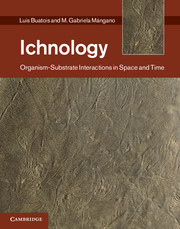Book contents
- Frontmatter
- Contents
- Acknowledgments
- Introduction
- Part I Conceptual tools and methods
- Part II Spatial trends
- 6 Trace fossils and paleoecology
- 7 Ichnology of shallow-marine clastic environments
- 8 Ichnology of marginal-marine environments
- 9 Ichnology of deep-marine clastic environments
- 10 Ichnology of continental environments
- 11 Ichnology of carbonate environments, rocky shorelines, and volcanic terrains
- Part III A matter of time
- References
- Index
10 - Ichnology of continental environments
from Part II - Spatial trends
Published online by Cambridge University Press: 25 October 2011
- Frontmatter
- Contents
- Acknowledgments
- Introduction
- Part I Conceptual tools and methods
- Part II Spatial trends
- 6 Trace fossils and paleoecology
- 7 Ichnology of shallow-marine clastic environments
- 8 Ichnology of marginal-marine environments
- 9 Ichnology of deep-marine clastic environments
- 10 Ichnology of continental environments
- 11 Ichnology of carbonate environments, rocky shorelines, and volcanic terrains
- Part III A matter of time
- References
- Index
Summary
The prevalent notion that trace fossils are comparatively rare in nonmarine facies is more a reflection of insufficient reconnaissance than of a true dearth of specimens.
Robert Frey and George Pemberton “The Psilonichnus ichnocoenose, and its relationship to adjacent marine and nonmarine ichnocoenoses along the Georgia coast” (1987)Vemos las cosas según como las interpretamos. Lo llamamos previsión: saber de antemano, estar prevenidos. Usted en el campo sigue el rastro de un ternero, ve huellas en la tierra seca, sabe que el animal está cansado porque las marcas son livianas y se orienta porque los pájaros bajan a picotear en el rastro. No puede buscar huellas al voleo, el rastreador debe primero saber lo que persigue: hombre, perro, puma. Y después ver. Lo mismo yo. Hay que tener una base y luego hay que inferir y deducir. Entonces – concluyó – uno ve lo que sabe y no puede ver si no sabe…Descubrir es ver de otro modo lo que nadie ha percibido. Ése es el asunto.. – Es raro, pensó Renzi, pero tiene razón –.
Ricardo Piglia Blanco Nocturno (2010)Historically invertebrate ichnology has focused on marine ichnofaunas. However, studies have gradually moved into freshwater and, more recently, terrestrial environments. As a result, continental ichnology has experienced a remarkable development during the last 15 years, and our perspective on this topic has changed dramatically. Earlier case studies started to show that continental invertebrate ichnofaunas were more varied and abundant than originally envisaged (e.g. Bromley and Asgaard, 1979; Bown, 1982; Pollard et al., 1982; Frey et al., 1984b; Walker, 1985; Ekdale and Picard, 1985; D’Alessandro et al., 1987; Gierlowski-Kordesch, 1991; Pickerill, 1992). It rapidly became clear that continental environments were as numerous and diverse as marine settings, and that such variability was indeed reflected in the ichnological record (Frey and Pemberton, 1987). Subsequent work focused on the expansion of the continental dataset, but more significantly in the proposal of archetypal ichnofacies in addition to the Scoyenia ichnofacies (Smith et al., 1993; Buatois and Mángano, 1995b, 2004a, 2007; Bromley, 1996; Genise et al., 2000, 2004b, 2010a). Also, the potential and limitations of the ichnofabric approach to the study of freshwater and terrestrial ichnofaunas have been addressed in a number of studies (e.g. Buatois and Mángano, 1998, 2007; Genise et al., 2004a; Buatois et al., 2007a). More recently, proposals have been made to define continental ichnofacies based on vertebrate trace fossils (Lockley et al., 1994; Hunt and Lucas, 2006a, 2007). There has also been a recent revival of continental neoichnology (e.g. Scott et al., 2007b; Smith and Hasiotis, 2008; Hembree, 2009; Genise et al., 2009). The fields of invertebrate and vertebrate ichnology have evolved independently, and research involves two separate scientific communities to a great extent (Lockley, 2007). This is certainly not a significant problem in marine ichnology, but it has had a negative impact on continental ichnology. The need to integrate vertebrate and invertebrate datasets has long been recognized (e.g. Buatois and Mángano, 1995b, 1996), but little progress has been attained. However, a series of recent papers seem to show that a better articulation between invertebrate and vertebrate ichnology is possible (e.g. Melchor et al., 2006; Lockley, 2007; Hunt and Lucas, 2007; Minter et al., 2007b; Scott et al., 2007b; Krapovickas et al., 2009). Integration of both datasets will be essential to produce more robust depositional models of continental environments.
- Type
- Chapter
- Information
- IchnologyOrganism-Substrate Interactions in Space and Time, pp. 197 - 216Publisher: Cambridge University PressPrint publication year: 2011

